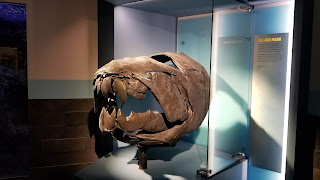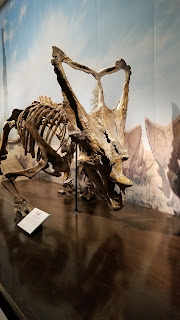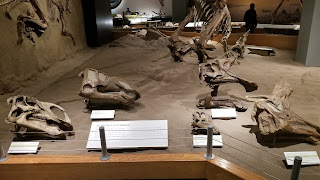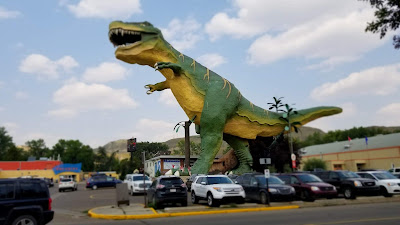If you love all things prehistoric or are in the Southern Alberta area a visit to the Royal Tyrrell Museum in Drumheller is highly recommended. 135km (84 miles) North East of Calgary, about a 1.5 hour drive, finds you in the middle of the Badlands, home to the plentiful fossil bearing strata of late Cretaceous formations. The museum is named in honour of Joseph Tyrrell, a geologist who accidentally discovered the first dinosaur in the Red deer River valley, Albertosaurus, in 1884. Many complete skeletons have been recovered from this region and are in museums from New York and Washington D.C. to the Natural History Museum in Ottawa (still waiting to be unwrapped from the plaster casts since the 19th century!). The museum has a broad selection of Cretaceous specimens from Alberta as well as many more boasting a collection of 130,000 fossils altogether. The Tyrrell opened in 1985 and attained Royal status in 1990, it's simply a designation under the prerogative of the crown to recognize any organization or institution as unique or exceptional.
Life-like Pachyrinosaurus grace the entrance
A diorama of Albertosaurs greet visitors with a realistic scene from Cretaceous Alberta.
Above a collection of fossils found in Alberta from every epoch of Earths natural history leads us through a collection of examples of the fundamentals of fossil science leading up to this large specimen.
A view of the Preparation Lab where you can see real specimens being uncovered, this museum is also a centre of research.
An appealing display called "Grounds For Discovery" tells the story of many important discoveries by oil development or even common excavation for housing or road work. Each display begins with "One day at work..." telling the story of how the specimen was discovered and then an explanation of why it's important, sometimes its an unknown or rare species in Alberta like the Borealopelta markmitchelli above, which turned out to be the best preserved armoured dinosaur in the world and also the oldest dinosaur discovered in Alberta.
A collection of scientific drawings on the way to the displays.
47,000 sq ft of the museums 121,000 sq ft is devoted to exhibits which are organized in chronological order, here your journey begins in the time tunnel with the dawn of life on Earth.
Here you walk through a darkened and glass-floored diorama of the Cambrian sea, based on fossils from the Burgess Shales of the nearby Rocky Mountains. The creatures depicted are about 400 times their natural size. As one species is highlighted with lighting a voice over explains their characteristics.
A range of fossils explains life in the early seas from jawed fishes to the first amphibians.
A life sized replica of a Devonian reef system, extremely intricate in every detail.
An exceptional diorama illustrating the first plants on land up to the Devonian forests where we see the small ancestor of dinosaurs climbing the tree.
A few of the early plant fossils
Some Devonian animals
A part of the 21m (69ft) long Ichthyosaur from northeastern British Columbia.
A welcome respite from all the bones is the living display "Cretaceous Garden" that features representations of plants that lived in Cretaceous Alberta such as ferns, magnolias, ginkos and meta sequoia.
Some of the plant collections including ginko at bottom.
Above, the interpretive plaque describes Metasequoia (Dawn Redwood) as a plant that was plentiful in the Cretaceous and thought extinct until discovered growing in China in the 1940's. A close up of the deciduous soft textured conifer.
An overview from the crowsnest
The "Dinosaur Hall" contains over 40 articulated dinosaur skeletons and begins with this Camarasaurus greeting you at the beginning of the Jurassic period face to face.
Allosaurus munches on a Camptosaurus
Stegosaurus with Ornitholestes at left
Gorgosaurus in a battle with an armoured dinosaur
A good amount of space is devoted to the Ceratopsians of Alberta of which there are many and new ones being discovered recently.
Chasmosaurus
The recently discovered Regaliceratops peterhewsi which means Royal horn face made national news when it was recognized only a few years ago.
The two groups of Ceratopsians defined, Centrosaurines and Chasmosaurines
Gorgosaurus dines on a Centrosaurus
A dromaeosaur in a vicious pose
A large collection of duck-billed dinosaurs of which Alberta also was home to
The largest duck bill Prosaurolophus posed with a petrified tree
A collection of duck bill heads
Corythosaurus
Fossils from Alberta proved that Ornithomimus had feathers which suits the name "Ostrich Mimic" although shouldn't it be the other way around?
Aren't ostriches the ones mimicking?
This South American Rhea at the Calgary Zoo reminded me of so many of these ostrich like dinosaurs!
This is a cast of the famous Struthiomimus in New York which was excavated from Dinosaur Provincial Park, Alberta in the early 20th century.
You will get a close up view of the head of Trannosaurus as you make your way through the second floor above. This specimen is mostly a cast from Montana but it's sheer size is impressive, it makes the Triceratops look like a light snack!
The marine reptile exhibit is very impressive, lit in blues and greens it is like being underwater as you gaze at these immense specimens. The info board in the middle says Mosasaurs were related to Komodo Dragons!
Given a few million years and the right conditions maybe I could evolve into a gigantic marine reptile?
Some of the weirder early mammals, sorry I'm a dino guy, don't know that much about these.
Some of the Ice Age mammals of North America ending in the modern day buffalo with Native petroglyphs appearing on the wall, this is the end of the museum, please exit through the gift shop!
Drumheller and Area Tips
The Tyrrell Museum took me about 2 hours to go through and I did it at a pretty leisurely pace, once you're done that you can have a snack at the on site cafeteria or bring a picnic lunch like I did and found a nice place just down the road. The museum is in a Provincial Park so there are a few pull outs and rest areas, I found a nice spot for lunch just before the Museum that has picnic tables and a path through the badlands.
This is an arid place full of Prickly Pear Cactus
There are plenty of interesting rock formations and slabs of sandstone.
This area was rich in coal and had many coal mines in the 19th and early 20th centuries. A little closer to town on the same road as the museum you'll find the old Mercury Mine site. There are no picnic sites here but some interpretive trails scattered with old mining equipment.
A little closer to town you'll see the whimsical dinos of Fossil World, a large retail store where you can buy fossils anywhere from a few dollars to thousands of dollars! You'll have to stop for the kids or they'll hate you forever.
Drumheller
This, of course, is the home of the "World's Largest Dinosaur". This guy is 26.3m (86ft) high and 46m (151ft) long, with a viewing area in the mouth, 106 stairs to the top. I didn't go up to the top as I was with my dog but I enjoyed this view from street level as it looms over the very normal street scene. The whole town is dinosaur themed from the many sculptures everywhere to the dino named streets, meet me at the corner of Gorgosaurus Ave and Triceratops St.
This is also the home of the local tourism office and nearby city water park for the kids
And not the worlds largest dino in the foreground, this guy is the original from when I was a kid.
Another Fossil World store across from the large T. Rex and more dinos around the streets.
Public park bench with dino
Dinosaur murals abound
My favourite outside the local butcher.
Drumheller is a cute little town now full of interesting boutiques, a far cry from it's coal days when this must have been a rough town. The best part is ample free parking! Coming from the city this is like a dream!
The Hoodoos
The hoodoos are a short 10 minute drive east of Drumheller, just follow the highway out of town through Rosedale past the Hoodoos campground and they will be on the left (north side) of the highway. There is a large parking lot although this was full when I went this summer. When I was a kid you could climb all over the hoodoos and there are home movies of my dad sitting on top of the tallest one, of course this is not allowed anymore! There are stairs and viewing areas all around the area encouraging people to stay off the fragile formations, don't be a dick please stay on the path! Adjacent there are many badland hills you can explore and climb all over, beware that some areas are steep and dangerous and wet badland clay is impossible to get a foothold on. A lot of these photos I took on a warm 20C day in November last year, almost no tourists or snakes! In the summer this free attraction is quite crowded.
This rock looks like it has fossilized plant material in it and on top one suspicious shoe!
There is literally petrified wood everywhere in the Badlands once you start looking, please do not collect it though!
I learned that the red shale seen here is actually a coal seam that caught fire and burned once. It's such a striking landscape who can even believe this is Canada? An hour and a half the other direction from Calgary will find you in the Rocky Mountains!
You can spend a whole day here or just visit the museum, keep in mind temperatures in the summer can reach the high 30'sC (90's F) with winters being quite cold and snowy. The best time to visit is from May to September.




































































































No comments:
Post a Comment